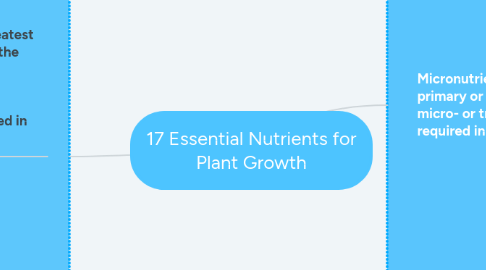
1. Macronutrients: are in the greatest quantity typically needed by the plant and are also known as primary nutrients. Secondary nutrients are needed in less quantities and are also included in this group.
1.1. Hydrogen
1.1.1. Function: pH regulation, water retention, synthesis of carbohydrates. It enhances plant symbiotic stress resistance.
1.1.2. Deficiency: Stunted growth.
1.2. Carbon
1.2.1. Function: Assists with the strength of plant structures.
1.2.2. Deficiency: Stunted growth, less water uptake.
1.3. Oxygen
1.3.1. Function: Respiration, energy production, plant structures
1.3.2. Deficiency: Leaves may wilt and be distorted and smaller than normal.
1.4. Nitrogen
1.4.1. Function; it is a constituent of many important molecules, including chlorophyll, and amino acids.
1.4.2. Deficiency: General chlorosis to a light green of the whole plant, accompanied by yellowing of the older leaves towards the younger leaves. Become spindly, stunted and secondary shoots grow poorly.
1.5. Potassium
1.5.1. Function: Promote formation of sugars for protein synthesis, cell division and increases the plant's resistance to disease.
1.5.2. Deficiency: Irreversible leaf edge chlorosis on new matured leaves, interveinal scorching and necrosis from leaf edge to the midrib.
1.6. Calcium
1.6.1. Function: Needed by plants to produce new growing point and root tips.
1.6.2. Deficiency: New foliage, buds and roots have stunted growth. Younger leaves grow downwards with browning of leaf edges and leaf tips. Roots become short and stubby.
1.7. Magnesium
1.7.1. Function: Promote the function of plant enzymes to produce carbohydrates, sugars and fats and in the regulation of nutrient adsorption.
1.7.2. Deficiency: Older leavers are chlorotic in between veins, interveinal chlorosis, Growth rate drops, reduced leaf size.
1.8. Phosphorous
1.8.1. Function: To promote photosynthesis, protein formation, seed germination, bloom stimulation and budding, phosphorus is required by plants. It hastens maturity, too.
1.8.2. Deficiency: Purple or bronze colouring due to the deposition of the pigment on the underside of older leaves, Anthocyanin. Affected plants grow very slowly and, compared with normal plants, are stunted.
1.9. Sulfur
1.9.1. Function: Protein, amino acid, vitamin and oil formation
1.9.2. Deficiency: Chlorosis of leaf due to reduced protein synthesis cause an impaired ability to form stable chlorophyll-protein complexes.
2. Micronutrients: Compared to primary or secondary nutrients, micro- or trace nutrients are required in small quantities.
2.1. Chlorine
2.1.1. Function: Chlorophyll formation, enzyme activity, cellular development.
2.1.2. Deficiency: Reduced growth, wilting of leaf tips.
2.2. Boron
2.2.1. Function: Needed in cell differentiation at the growing tips of plants where cell division is active.
2.2.2. Deficiency: Plants become stunted and deformed. Witches broom can be observed, loss of apical dominance.
2.3. Iron
2.3.1. Function: Synthesize of chloroplast proteins and various enzymes.
2.3.2. Deficiency: Light green to yellow interveinal chlorosis on new leaves. Leaves may reduce in size and turn nearly white, with necrotic spots.
2.4. Manganese
2.4.1. Function: Photosynthesis, respiration, and enzyme reaction.
2.4.2. Deficiency: Diffused interveinal chlorosis with poorly defined green areas around the veins in new leaves. Chlorosis and necrotic spotting.
2.5. Zinc
2.5.1. Function: Needed to activate plant growth regulators
2.5.2. Deficiency: Chlorosis bronzing or mottling of younger leaves. Interveinal chlorosis of young leaves, reduced shoot growth with short internodes.
2.6. Copper
2.6.1. Function: Assists with enzyme activity.
2.6.2. Deficiency: Stunted growth, distortion and loss of young leaves.
2.7. Nickel
2.7.1. Function: Mobilization of nitrogen during seed germination
2.7.2. Deficiency: Depressed seedling vigor, chlorosis, necrotic lesion in leaves.
2.8. Molybdenum
2.8.1. Function: Enzyme activity and nitrogen fixation in legumes.
2.8.2. Deficiency: Twisted and deformed young leaves, necrosis and chlorosis.
